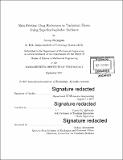Skin friction drag reduction in turbulent flows using superhydrophobic surfaces
Author(s)
Rajappan, Anoop
DownloadFull printable version (12.43Mb)
Other Contributors
Massachusetts Institute of Technology. Department of Mechanical Engineering.
Advisor
Gareth H. McKinley.
Terms of use
Metadata
Show full item recordAbstract
The use of randomly textured superhydrophobic surfaces have recently gained interest as a potential approach for the passive reduction of skinfriction on the hull of ships, submarines and underwater projectiles. When submerged in water, these surfaces trap a layer of air (or 'plastron') within their texture, which allows the external fluid to partially slip over the boundary, decreasing the net frictional shear stress on the wall. Five prototype drag-reducing surfaces were evaluated experimentally as possible candidates for turbulent drag reduction applications, using a combination of flow tests, surface profile measurements, and contact angle goniometry. Three of these were randomly rough superhydrophobic textures, produced by easily scalable mechanical and chemical surface treatment processes; the other two surfaces consisted of periodic streamwise grooves, filled with air or a low viscosity liquid lubricant. The skin friction characteristics of all five prototype surfaces were measured in fully turbulent flow inside a custom-built Taylor-Couette apparatus for Reynolds numbers in the range 1.64 x 104 </= Re </= 8.59 x 104, and a characteristic slip length was determined for each surface from frictional torque measurements. Drag reductions of up to 26%, and effective slip lengths as large as 32 pm, were obtained during flow tests on superhydrophobic surfaces. Consistent with the results of previous studies in the the literature, the percentage drag reduction was found to increase with increasing flow Reynolds numbers; furthermore, the effective slip length for each surface remained approximately constant with Re, until the onset of surface failure. The surface morphology of each of the three rough superhydrophobic textures was further characterized through non-contact optical profilometry, and a number of surface statistical parameters quantifying the vertical and lateral length scales of roughness features were computed from the measured height profile. These were then compared with the experimentally determined slip lengths, to extract correlations between specific roughness parameters and drag reduction performance, and to identify desirable features of surface roughness that enhance slip length and interface stability under turbulent flow conditions. Analogous to regularly patterned surfaces, the slip length was found to depend strongly on the lateral spacing of texture asperities, quantified by the mean autocorrelation length in the case of fractal self-affine rough surfaces. Finally, a large lateral spacing between roughness peaks, along with a small root mean square roughness (compared to the viscous length scale of the turbulent flow), and the presence of a hierarchical texture with roughness features at two or more length scales, were identified as the three key requirements for the successful design of rough superhydrophobic surfaces for turbulent drag reduction in practical applications.
Description
Thesis: S.M., Massachusetts Institute of Technology, Department of Mechanical Engineering, 2017. Cataloged from PDF version of thesis. Includes bibliographical references (pages 127-136).
Date issued
2017Department
Massachusetts Institute of Technology. Department of Mechanical EngineeringPublisher
Massachusetts Institute of Technology
Keywords
Mechanical Engineering.